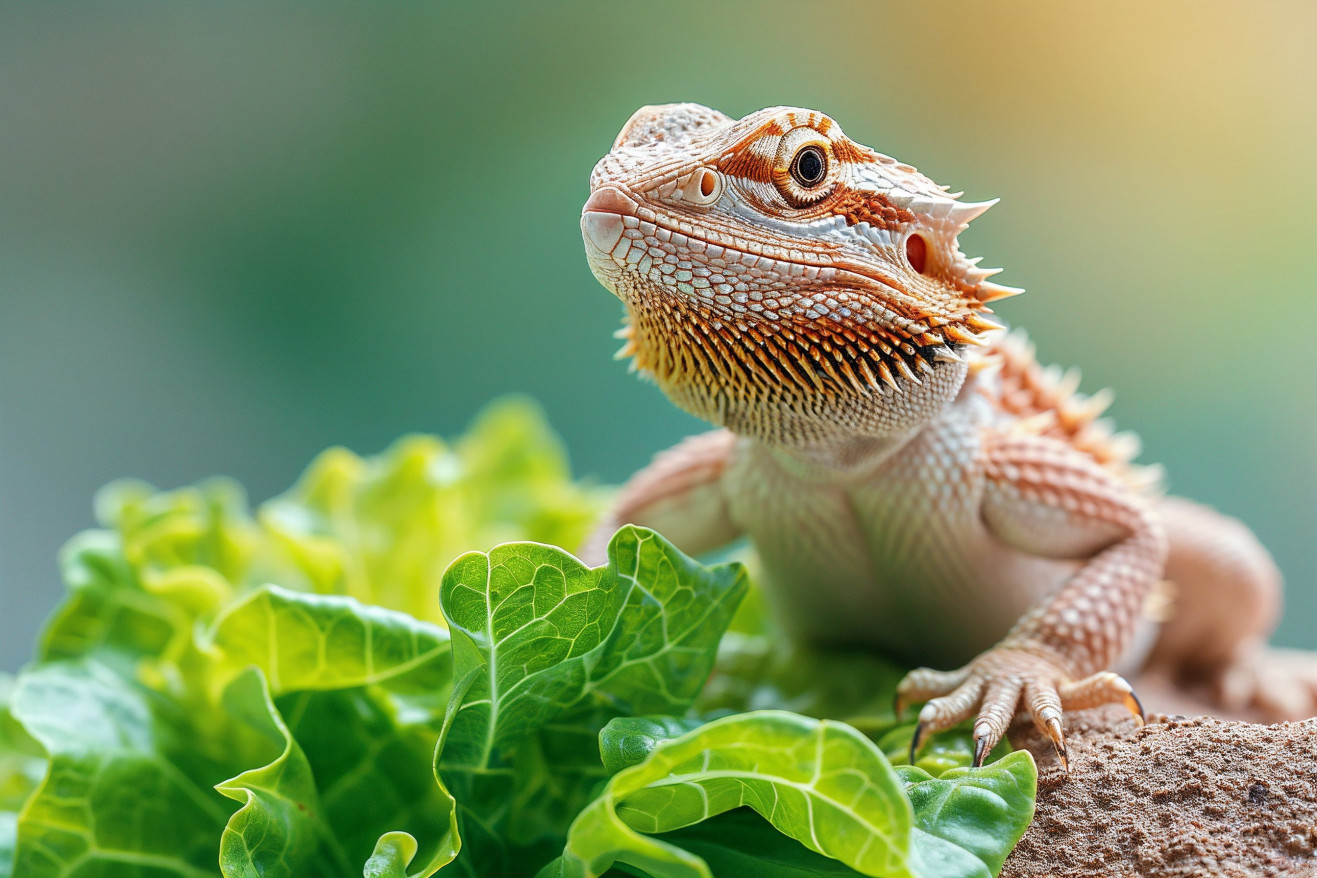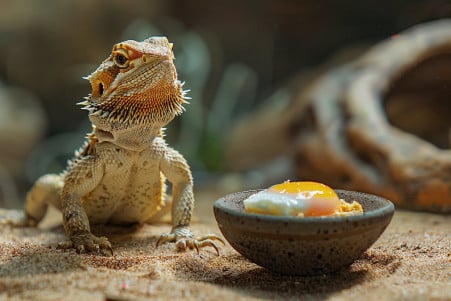Can Bearded Dragons Eat Romaine Lettuce? Nutritional Facts & Best Practices
2 February 2024

While bearded dragons can eat a variety of foods, romaine lettuce may not be the best choice. This is because romaine lettuce is low in nutritional value and has a poor calcium-to-phosphorus ratio. As a result, it’s recommended that you feed your bearded dragon other foods that offer more nutritional value.
This article will go into the nutritional science behind what bearded dragons should eat. It will cover nutritional recommendations, advice from veterinarians, and research from the field of herpetology to explain how foods like romaine lettuce can impact the health of these reptiles. It will also explain the importance of vitamins, minerals, and hydration for bearded dragons, so you can better understand what to feed them and how to keep them healthy.
Can bearded dragons eat romaine lettuce?
Nutritional Value of Romaine Lettuce in a Bearded Dragon’s Diet
While romaine lettuce is often praised for its crunchy texture and hydrating properties in human diets, it turns out that it may not be as beneficial for bearded dragons. According to Dragon’s Diet, the calcium-to-phosphorus ratio is one of the most important things to consider when feeding a bearded dragon.
A good diet will have a high calcium-to-phosphorus ratio to prevent metabolic bone disease (MBD). Unfortunately, romaine lettuce has a calcium-to-phosphorus ratio that is not good for the health of these reptiles.
In addition, Zen Habitats explains that while hydration is important, the high water content of romaine lettuce may not be enough to meet the nutritional needs of bearded dragons. The water in romaine lettuce may fill a dragon’s stomach without providing the necessary nutrients, leading to dietary dilution and malnutrition.
This is especially concerning because bearded dragons are known to be picky eaters in captivity, so it’s important to make sure they’re getting the most nutritional value out of the foods they eat.
When you look at the nutritional content of romaine lettuce, it becomes clear that a diet that’s high in low-nutrient foods like this leafy green can lead to serious health problems for bearded dragons. This makes it clear that it’s important to make sure that bearded dragons are fed a balanced and appropriate diet to ensure their health and well-being.
Signs and How to Prevent Nutritional Deficiencies in Bearded Dragons
Visible signs of malnutrition, like a lack of energy and a thin tail, are often the result of an unbalanced diet in bearded dragons that doesn’t provide the necessary vitamins, calcium, and protein.
A study from The Bug Shed found that a lack of variety in a bearded dragon’s diet can lead to or exacerbate issues like sunken fat pads or obesity in bearded dragons, both of which can make it look like the animal is getting the nutrients it needs.
One of the most serious risks of an inappropriate diet is metabolic bone disease (MBD), a common but preventable condition in reptiles that’s most often caused by a lack of calcium, especially when the calcium-to-phosphorus ratio in the diet is off, as is the case with romaine lettuce.
According to Mazuri, MBD is often irreversible, and symptoms include a swollen jaw and limb trembling, which makes it especially important to make sure bearded dragons are getting a balanced diet.
To avoid these issues, make sure that bearded dragons are eating a variety of foods that are high in the nutrients they need. While feeding bearded dragons romaine lettuce and other low-nutrient foods won’t necessarily cause immediate problems, over time it can lead to nutritional deficiencies that can cause serious health problems.
To make sure that bearded dragons are healthy, it’s important to feed them foods that will meet their nutritional needs and minimize the risks of an unbalanced diet.
Improving Bearded Dragon Nutrition With Essential Supplements
While romaine lettuce can provide hydration, it doesn’t offer the nutritional value of calcium and vitamin D3, which are both essential to bearded dragon health.
Dragon’s Diet explains that a diet high in calcium and low in phosphorus is the most important factor in preventing metabolic bone disease. To make sure your bearded dragon is getting the right nutritional supplements, Bearded Dragons World suggests dusting their food with calcium powder, especially for growing juveniles and gravid females.
In addition to supplements, UVB lighting is important for calcium absorption because it helps the skin synthesize vitamin D3. Dr. Amna Ahmad explains that even with a diet supplemented with calcium and vitamin D3, studies on bearded dragon health have shown that hypocalcemia can still occur if the dragon doesn’t get enough UVB light.
To make sure your bearded dragon is getting a more well-rounded and nutritious diet, you can also add in some other leafy greens that have a better calcium-to-phosphorus ratio than romaine lettuce. Collard greens, turnip greens, and mustard greens are all great options that will give your bearded dragon the calcium boost they need.
You can start to incorporate these greens into their diet slowly to make sure they’re getting a good variety of nutrients, which leads us to the next section about feeding behaviors and preferences that will help ensure your bearded dragon is as healthy as possible.
Growth-Dependent Diets for Bearded Dragons
Bearded dragons’ diets change dramatically from the time they are juveniles to when they reach adulthood. When they are young, bearded dragons have a high protein requirement, so According to Falls Road Animal Hospital, a diet composed of approximately 80% insects and 20% plants is recommended. An insect-heavy diet is important to support their fast growth.
However, when they reach adulthood at around 18 months, their diet should be 80% plants and 20% insects. This change in diet is necessary to keep them from becoming overweight.
Bearded dragons need a wide variety of plants and vegetables to keep their diets interesting and to ensure they get all the vitamins and minerals they need. A good diet will include staples like collard greens, turnip greens, mustard greens, and some safe fruits like apples and berries, so that they don’t become reliant on any one food.
While romaine lettuce isn’t toxic, it’s best to feed it to bearded dragons in moderation because it doesn’t have much nutritional value. Bearded dragons need a diet that will help them thrive, not just survive, and that means feeding them foods that will support their overall health.
It’s better to stick to more nutrient-dense vegetables. By feeding them a diet that includes a variety of nutrient-dense foods, their owners can help prevent common health problems and encourage them to try new greens and vegetables.
The Best Vegetables to Feed Your Bearded Dragon
When it comes to feeding bearded dragons, the more variety, the better. This is especially true when it comes to the leafy greens that make up the bulk of their diet.
Not only do you want to make sure that you’re feeding your pet a variety of different greens, but you also want to make sure that the greens you’re feeding them are nutritionally sound, with a special focus on a high calcium-to-phosphorus ratio, low oxalates, and a good vitamin content.
For example, Spruce Pets recommends dark, leafy greens like endive, chicory, and spring mix, which is a combination of romaine and other greens that offers a more balanced nutritional profile.
While romaine lettuce can be hydrating, it’s not the most nutritious option. Instead, you may want to consider nutrient-rich alternatives like dandelion greens, mustard greens, and turnip greens, which are recommended by Hepper. Not only do these options offer a variety of essential vitamins and minerals, but they also have good calcium-to-phosphorus ratios, which means they can be fed to your pet daily.
When you’re introducing new greens to your bearded dragon, do so slowly. You can help your pet get used to new options by mixing small pieces of the new greens in with the ones they’re already used to.
In addition to that, you can help ensure that your pet doesn’t get bored and that they’re getting a variety of nutrients by rotating the greens that you offer.
That said, it’s important to be patient and consistent when you’re trying to expand your pet’s palate. This approach to diet diversity is in line with JoshsFrogs’ recommendation of fresh vegetables, and it will help ensure that your bearded dragon gets the variety they need to stay healthy.
Recap: Can Bearded Dragons Eat Romaine Lettuce?
In summary, while romaine lettuce can help bearded dragons stay hydrated, it doesn’t provide the nutrients that bearded dragons need in their diet. This article has stressed the importance of a balanced diet for bearded dragons, with a focus on vegetables as a key part of their diet.
Vegetables that are high in calcium, low in phosphorus and oxalates, and full of vitamins are the best options for bearded dragons, not leafy greens that are high in water and low in nutrients like romaine lettuce.
Bearded dragons also need dietary supplements and UVB lighting to make sure they can absorb the calcium they need and stay healthy overall. These things will help prevent metabolic bone disease and other health problems that can come from an unbalanced diet.
It’s up to bearded dragon owners to make sure they’re making the right choices about their pet’s diet. The most important things to remember are to make sure that you’re feeding your bearded dragon nutrient-dense vegetables, using supplements responsibly, and making sure that you’re providing a balanced diet that’s supplemented with UVB lighting.
If you do these things, you can help ensure that your scaly friend lives a long, healthy life.


